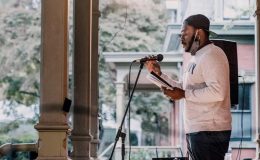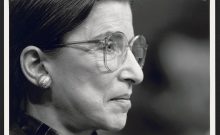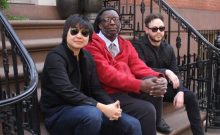Maybe you’ve heard of The Next Big Thing, the latest spin on an old time chain letter. It’s a blog chain that’s circulating in which a writer answers ten prefab interview questions about a current project, then tags a handful of other writers to do the same. I was tagged in by Leah Umansky whose new book of poems, Domestic Uncertainties (with the author’s very cool collage based on Emily Bronte’s Wuthering Heights on the cover) is hot off the press at BlazeVox. Here’s my TNBT post:
What is your working title of your book (or story)?
I’m working on a novel and also on a new collection of poems. The novel is in its ninth iteration and will be in process for a while, still. The poetry collection, Air Hunger, is closer to birth so I’ll talk about that one here.
Where did the idea come from for the book?
A lot of what we write circles around a wound we have experienced or witnessed. I wanted to write a book that cones down on the notion of the original wound, the earliest one, that we rehearse or repeat until/unless we somehow figure it out, and to write it in a way that is intimate, and also transcends personal landscape.
What genre does your book fall under?
Literary poetry.
Which actors would you choose to play your characters in a movie rendition?
Bob Holman would play the father. The sister would be Brenda Shaughnessy, and the mother could be played by Alice Notley. The antihero, Johnny, would be played by Randall Horton. The part of the shaman who briefly appears would be played by Vijay Seshadri, the protagonist by Lucie Brock-Broido (as a first-time open mic reader), the grandmother by May Sarton, and the part of the wind whistling on the roof would be played by Lucille Clifton.
What is the one-sentence synopsis of your book?
The infant has an invisible template of family anguish transcribed onto her psyche and spirit, a template which proves both barrier, and tool with which to heal—if in fact healing is possible.
Will your book be self-published or represented by an agency?
As the publisher, myself, of an independent literary small press, I could bring this book out through Kattywompus Press. I will probably publish a book of my own under my press eventually—but not likely this one. There are a number of small presses I love, where I hope this collection might be considered for publication. As for an agent, for a poetry book—surely you jest.
How long did it take you to write the first draft of your manuscript?
Several months for the first part, and then I workshopped it with Cornelius Eady, who told me bluntly it was not a chapbook but a full length collection, and to get cracking on the rest. I wrote three more poems that same night, and the rest continue to trickle in.
What other books would you compare this story to within your genre?
Pardon my French, but screw genre. Get me out of those boxes! As for comparing, please let’s not, it makes me sound like such a Very Serious Person (to crib from DeWitt Brinson, and maybe Eeyore). Let’s play a different game instead: I’ll toss you some random snippets of poet DNA that I think may have spliced in with my double-strand. Rilke, Notley, Eady, Yau, Orr, Brainard, Sarton, Hillman, Rich, Millay, oh, we could do this all day. There, see? I can even do end-rhymes.
Who or what inspired you to write this book?
The desire to write about an aspect of my own and witnessed experience in a deep enough way that I could move on from it. Passages of the manuscript address subject matter I was not willing to write about before, other portions revolve around what have proved the most durable of my writerly obsessions. There is a lot of grief in it, also a pinch of magic, of visionary clarity. Like most poetry it is peopled by ghosts.
What else about your book might pique the reader’s interest?
The longest poem in the collection, False Haiku: a children’s story is written as a several-page series of strictly syllabated 5-7-5 segments, like the snapshots of a flip-book which accrue to a moving picture. Structures range from prose poems to free verse, a shaped poem, and several pieces in the fragmented syntax of experimental contemporary poets. The conceptual core of the book, the idea of the original wound, is in some way archetypal and so this collection offers an opportunity to examine those archetypes of the wounded and the wounder, of the survivor and the lost one who perishes in the storm. In my writing I am always working, more and less consciously, towards some moment of healing or at least insight. I am, most often, speaking directly to the one who was lost—sometimes in the person of actual individuals I have lost along the way and occasionally in the form of my child self, speaking to the secret and ungrieved losses. And I don’t think there is anything very special or unique about any of that, so I see the book on some level as a story, in the form of poems, that is about everybody and anybody.
Check their blogs next week for The Next Big Thing.
With love,
sammy






Leave a Comment
You must be logged in to post a comment.